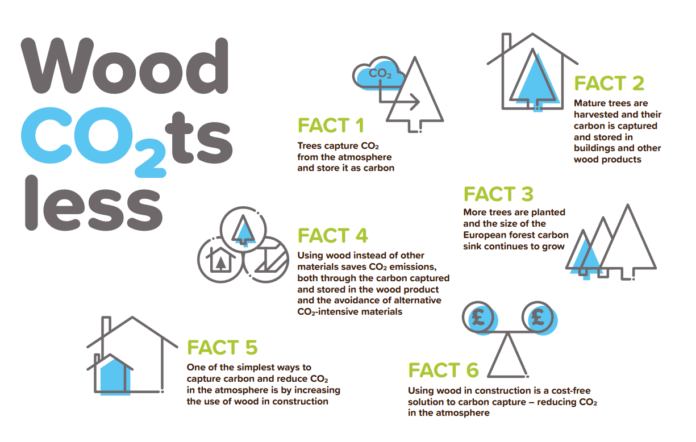Södra has pledged its support for Swedish Wood and Wood for Good’s Wood Co₂ts less campaign. The campaign, which officially launched on 13 July, is an industry-wide initiative developed for UK timber associations and member companies.
Its aim is to promote the use of all wood products as low carbon materials and illustrate how using wood can help reduce CO₂ in the atmosphere and contribute to slowing climate heating.
On the campaign, Jeremy English, sales director at Södra, said: “It’s heartening to see the timber industry rallying around one common goal: to raise awareness of timber’s environmental benefits. It’s a brilliant campaign and as a member of both Swedish Wood and Wood for Good – and a passionate advocate for the benefits of building with responsibly-sourced timber – we’re of course proud to support it.”
Four key facts form the staple of the Wood Co₂ts less campaign include:
- Using wood from sustainably managed forests instead of other materials is one of the simplest ways to reduce the carbon emissions generated by the construction industry.
- Wood captures and stores carbon for the life of the wood product.
- Using wood instead of other materials saves CO₂ emissions, both through the carbon captured and stored in the wood product and the avoidance of using alternative CO₂-intensive materials.
- Using wood in construction is a cost-effective solution to carbon capture.
“To those in the industry, the benefits of building with timber are no secret,” explained Jeremy. “But part of this campaign’s aim is to reach those beyond the timber industry. Unfortunately, many out there still believe that cutting down trees must be bad for the environment. In reality, if timber is responsibly sourced from suppliers like Södra, then this couldn’t be further from the truth. For example, for every tree we cut down, we plant another three in its place.”
The facts certainly bring Jeremy’s comments sharply into focus. Between 2005 and 2015 the average annual sequestration of carbon in forest biomass reached 719 million tonnes in the European region, corresponding to about 9% of the region’s net greenhouse gas emissions (according to the United Nations). The Committee on Climate Change has also said that using wood in construction to displace high-carbon materials such as cement and steel is one of the most effective ways to use limited biomass resources to mitigate climate change.
“It’s a well-known fact that cement-making is one of the world’s biggest carbon emission culprits, accounting for 8% the global total,” concluded Jeremy. “Alternatively, responsibly managed forests have always been the earth’s air cleaners and will continue to be so forever. And a by-product of responsibly managed forests? High-quality, sustainable timber; timber that has already taken from the air and locked away decades’ worth of harmful CO2.”
Visit woodforgood.com/CO2 for more information and search #WoodCo₂tsless to join the conversation on social media.




